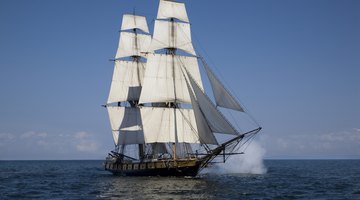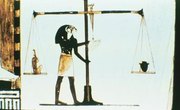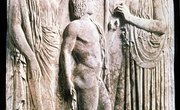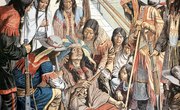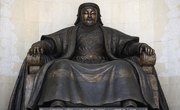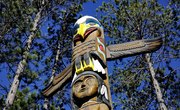The Greeks believed land floated on a giant body of water called the Okeanos, controlled by a titan of the same name. Most bodies of water carried similarly mystical connotations; the ocean was home to dangerous monsters like the Scylla and Charybdis, while some rivers led directly to the underworld. As a result, those who traveled in water vessels often encountered a number of supernatural and practical dangers on their voyages.
The Argo
Jason and his crew, called the Minyans or the Argonauts, sailed on the Argo, a ship built by and named after Argus. Athena, the goddess of wisdom, guided Argus in constructing the Argo, which proved to be the fastest, strongest vessel in Greek mythology. Though Jason was the de facto leader of the Argonauts, Argus played a larger role in ensuring the Argo functioned perfectly, whether they were using oars or sails. As a result of the superior design, the Argo was able to avoid being crushed by the collision of the Cyanean rocks as well as outmaneuver all other water vessels.
The Doomed Ships of Odysseus
Odysseus served as the captain of Agamemnon's ship en route to Troy, sailing first to sacrifice one hundred cattle to Apollo, then traveling to Troy, where the Greeks were eventually victorious. However, his return journey was far more eventful. He commanded 12 ships, yet lost 11 to King Antiphates and his army of Laestrygonian ogres. The final ship was destroyed by the whirlpool monster Charybdis. Odysseus was reduced to floating in the sea on a piece of driftwood before the Phraeacians agreed to help him sail home to Ithaca.
The Black Sails of Theseus
Theseus sailed to Crete to halt a macabre ritual. Every nine years, Athens would send a tribute of 14 Athenian youths to Crete, where King Minos sacrificed them to the man-ox hybrid, the Minotaur. His father, Aegeus, feared for his son's life, and asked that Theseus put up white sails if he survived the journey. With the help of Princess Ariadne of Crete, Theseus killed the Minotaur and made his way out of the Labyrinth where the beast lived. However, after losing Ariadne on one of the islands, Theseus forgot to change his sails. When Aegeus saw the black sails, he thought his son had perished and jumped to his death in grief.
Ferry of the Underworld
Not all water vessels in Greek mythology were built and manned by humans. Charon rowed the souls, or shades, of the dead across the Akherousian marsh to their final resting place in the underworld. He would accept all who could pay his fare of a single coin, on the condition that none of his passengers could return to the upper world. He refused to transport passengers who couldn't pay the fare or who received improper burial, though he was, at times willing to allow gods like Dionysius and heroes like Aeneas into his ferry.
Related Articles
References
- The World of Odysseus, Moses L. Finley
- The Cosmological World of the Greeks, Hector MacPherson
- Theoi Greek Mythology: Okeanos
- The Internet Classics Archive: The Argonautica Book I
- The Internet Classics Archive: The Argonautica Book II
- Project Gutenberg: The Iliad of Homer
- Project Gutenberg: The Odyssey
- University of Chicago: The Parallel Lives by Plutarch
- Theoi Greek Mythology: Kharon
- Project Gutenberg: Virgil's Aeneid in English
Writer Bio
Since 2003, Momi Awana's writing has been featured in "The Hawaii Independent," "Tradewinds" and "Eternal Portraits." She served as a communications specialist at the Hawaii State Legislature and currently teaches writing classes at her library. Awana holds a Master of Arts in English from University of Hawaii, Mānoa.

